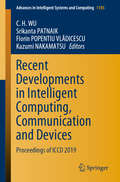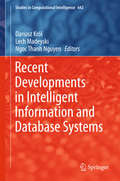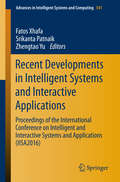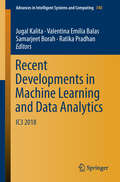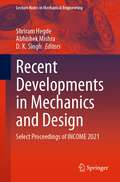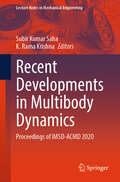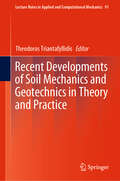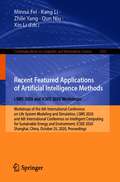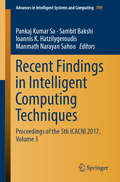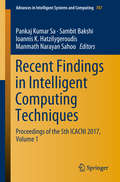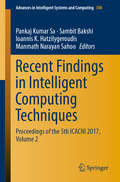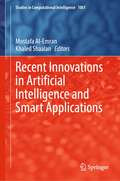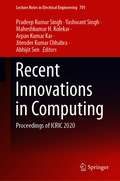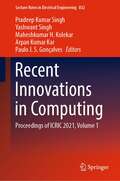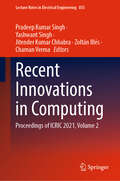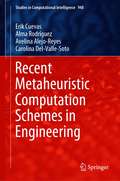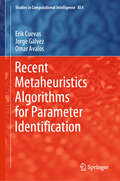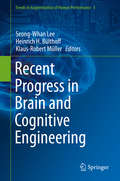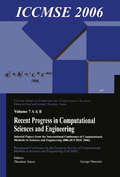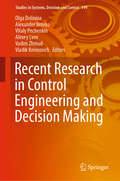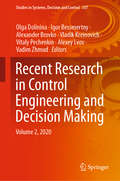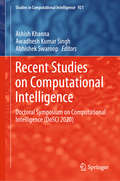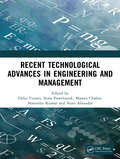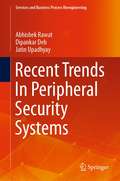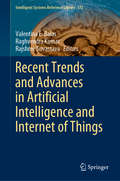- Table View
- List View
Recent Developments in Intelligent Computing, Communication and Devices: Proceedings of ICCD 2019 (Advances in Intelligent Systems and Computing #1185)
by Srikanta Patnaik Kazumi Nakamatsu C. H. Wu Florin Popentiu VlãdicescuThis book gathers high-quality papers presented at the 5th International Conference on Intelligent Computing, Communication & Devices (ICCD 2019), held in Xi'an, China on November 22–24, 2019. The contributions focus on emergent fields of intelligent computing and the development of a new generation of intelligent systems. Further, they discuss virtually all dimensions of the intelligent sciences, including intelligent computing, intelligent communication and intelligent devices.
Recent Developments in Intelligent Information and Database Systems
by Lech Madeyski Ngoc Thanh Nguyen Dariusz KrólThe objective of this book is to contribute to the development of the intelligent information and database systems with the essentials of current knowledge, experience and know-how. The book contains a selection of 40 chapters based on original research presented as posters during the 8th Asian Conference on Intelligent Information and Database Systems (ACIIDS 2016) held on 14 16 March 2016 in Da Nang, Vietnam. The papers to some extent reflect the achievements of scientific teams from 17 countries in five continents. The volume is divided into six parts: (a) Computational Intelligence in Data Mining and Machine Learning, (b) Ontologies, Social Networks and Recommendation Systems, (c) Web Services, Cloud Computing, Security and Intelligent Internet Systems, (d) Knowledge Management and Language Processing, (e) Image, Video, Motion Analysis and Recognition, and (f) Advanced Computing Applications and Technologies. The book is an excellent resource for researchers, those working in artificial intelligence, multimedia, networks and big data technologies, as well as for students interested in computer science and other related fields. "
Recent Developments in Intelligent Systems and Interactive Applications
by Fatos Xhafa Srikanta Patnaik Zhengtao YuThis book provides the latest research findings and developments in the field of interactive intelligent systems, addressing diverse areas such as autonomous systems, Internet and cloud computing, pattern recognition and vision systems, mobile computing and intelligent networking, and e-enabled systems. It gathers selected papers from the International Conference on Intelligent and Interactive Systems and Applications (IISA2016) held on June 25-26, 2016 in Shanghai, China. Interactive intelligent systems are among the most important multi-disciplinary research and development domains of artificial intelligence, human-computer interaction, machine learning and new Internet-based technologies. Accordingly, these systems embrace a considerable number of application areas such as autonomous systems, expert systems, mobile systems, recommender systems, knowledge-based and semantic web-based systems, virtual communication environments, and decision support systems, to name a few.
Recent Developments in Machine Learning and Data Analytics: IC3 2018 (Advances in Intelligent Systems and Computing #740)
by Valentina Emilia Balas Samarjeet Borah Jugal Kalita Ratika PradhanThis book presents high-quality papers from an international forum for research on computational approaches to learning. It includes current research and findings from various research labs, universities and institutions that may lead to development of marketable products. It also provides solid support for these findings in the form of empirical studies, theoretical analysis, or comparison to psychological phenomena. Further, it features work that shows how to apply learning methods to solve important application problems as well as how machine learning research is conducted. The book is divided into two main parts: Machine Learning Techniques, which covers machine learning-related research and findings; and, Data Analytics, which introduces recent developments in this domain. Additionally, the book includes work on data analytics using machine learning techniques.
Recent Developments in Mechanics and Design: Select Proceedings of INCOME 2021 (Lecture Notes in Mechanical Engineering)
by Abhishek Mishra Shriram Hegde D. K. SinghThe book presents select proceedings of the International Conference on Mechanical Engineering (INCOME 2021). It includes the topics related to design and functional requirements of components used in mechanical systems. The contents covered include concept design, detailed design, structural design, mechanics, static and dynamic systems. The book also discusses various methods of software aided design and analysis. Given the contents, the book will be a valuable reference for beginners, researchers, and professionals working in various domains of mechanical engineering.
Recent Developments in Multibody Dynamics: Proceedings of IMSD-ACMD 2020 (Lecture Notes in Mechanical Engineering)
by Subir Kumar Saha K. Rama KrishnaThis book contains papers presented during the 10th Asian Conference on Multibody Systems (ACMD) and 6th Joint International Conference on Multibody System Dynamics (IMSD). The papers cover the state-of-the-art research relating to multibody dynamics, including the development of algorithms, computational efficiency, and analytical outlooks. It focuses on the utilization of multibody systems for social application, with sections catering to the field of flexible body dynamics and vehicle dynamics as well. This book can be a valuable resource to professionals, academics, automotive engineers, and machine tool manufacturers.
Recent Developments of Soil Mechanics and Geotechnics in Theory and Practice (Lecture Notes in Applied and Computational Mechanics #91)
by Theodoros TriantafyllidisThis book provides essential insights into recent developments in fundamental geotechnical engineering research. Special emphasis is given to a new family of constitutive soil description methods, which take into account the recent loading history and the dilatancy effects. Particular attention is also paid to the numerical implementation of multi-phase material under dynamic loads, and to geotechnical installation processes. In turn, the book addresses implementation problems concerning large deformations in soils during piling operations or densification processes, and discusses the limitations of the respective methods. Numerical simulations of dynamic consolidation processes are presented in slope stability analysis under seismic excitation. Lastly, achieving the energy transition from conventional to renewable sources will call for geotechnical expertise. Consequently, the book explores and analyzes a selection of interesting problems involving the stability and serviceability of supporting structures, and provides new solutions approaches for practitioners and scientists in geotechnical engineering. The content reflects the outcomes of the Colloquium on Geotechnical Engineering 2019 (Geotechnik Kolloquium), held in Karlsruhe, Germany in September 2019.
Recent Featured Applications of Artificial Intelligence Methods. LSMS 2020 and ICSEE 2020 Workshops: Workshops of the 6th International Conference on Life System Modeling and Simulation, LSMS 2020, and 6th International Conference on Intelligent Computing for Sustainable Energy and Environment, ICSEE 2020, Shanghai, China, October 25, 2020, Proceedings (Communications in Computer and Information Science #1303)
by Xin Li Kang Li Qun Niu Zhile Yang Minrui FeiThis book constitutes the thoroughly refereed proceedings of the themed workshops of the 6th International Conference on Life System Modeling and Simulation, LSMS 2020, and of the 6th International Conference on Intelligent Computing for Sustainable Energy and Environment, ICSEE 2020, held in Hangzhou, China, in October 2020.The 36 full and 2 short papers presented were carefully reviewed and selected from over 165 submissions. The papers of this volume are organized in topical sections on: smart energy systems and devices; intelligent manufacturing and systems; and intelligent biology and information systems.
Recent Findings in Intelligent Computing Techniques: Proceedings Of The 5th Icacni 2017, Volume 2 (Advances In Intelligent Systems and Computing #708)
by Pankaj Kumar Sa Manmath Narayan Sahoo Sambit Bakshi Ioannis K. HatzilygeroudisThis three volume book contains the Proceedings of 5th International Conference on Advanced Computing, Networking and Informatics (ICACNI 2017). The book focuses on the recent advancement of the broad areas of advanced computing, networking and informatics. It also includes novel approaches devised by researchers from across the globe. This book brings together academic scientists, professors, research scholars and students to share and disseminate information on knowledge and scientific research works related to computing, networking, and informatics to discuss the practical challenges encountered and the solutions adopted. The book also promotes translation of basic research into applied investigation and convert applied investigation into practice.
Recent Findings in Intelligent Computing Techniques: Proceedings Of The 5th Icacni 2017, Volume 2 (Advances In Intelligent Systems and Computing #708)
by Pankaj Kumar Sa Manmath Narayan Sahoo Sambit Bakshi Ioannis K. HatzilygeroudisThis three volume book contains the Proceedings of 5th International Conference on Advanced Computing, Networking and Informatics (ICACNI 2017). The book focuses on the recent advancement of the broad areas of advanced computing, networking and informatics. It also includes novel approaches devised by researchers from across the globe. This book brings together academic scientists, professors, research scholars and students to share and disseminate information on knowledge and scientific research works related to computing, networking, and informatics to discuss the practical challenges encountered and the solutions adopted. The book also promotes translation of basic research into applied investigation and convert applied investigation into practice.
Recent Findings in Intelligent Computing Techniques: Proceedings Of The 5th Icacni 2017, Volume 2 (Advances In Intelligent Systems and Computing #708)
by Pankaj Kumar Sa Manmath Narayan Sahoo Sambit Bakshi Ioannis K. HatzilygeroudisThis three volume book contains the Proceedings of 5th International Conference on Advanced Computing, Networking and Informatics (ICACNI 2017). The book focuses on the recent advancement of the broad areas of advanced computing, networking and informatics. It also includes novel approaches devised by researchers from across the globe. This book brings together academic scientists, professors, research scholars and students to share and disseminate information on knowledge and scientific research works related to computing, networking, and informatics to discuss the practical challenges encountered and the solutions adopted. The book also promotes translation of basic research into applied investigation and convert applied investigation into practice.
Recent Innovations in Artificial Intelligence and Smart Applications (Studies in Computational Intelligence #1061)
by Khaled Shaalan Mostafa Al-EmranThis book tackles the recent research trends on the role of AI in advancing automotive manufacturing, augmented reality, sustainable development in smart cities, telemedicine, and robotics. It sheds light on the recent AI innovations in classical machine learning, deep learning, Internet of Things (IoT), Blockchain, knowledge representation, knowledge management, big data, and natural language processing (NLP). The edited book covers empirical and reviews studies that primarily concentrate on the aforementioned issues, which would assist scholars in pursuing future research in the domain and identifying the possible future developments of AI applications.
Recent Innovations in Computing: Proceedings of ICRIC 2020 (Lecture Notes in Electrical Engineering #701)
by Arpan Kumar Kar Pradeep Kumar Singh Maheshkumar H. Kolekar Jitender Kumar Chhabra Yashwant Singh Abhijit SenThis book features selected papers presented at the 3rd International Conference on Recent Innovations in Computing (ICRIC 2020), held on 20–21 March 2020 at the Central University of Jammu, India, and organized by the university’s Department of Computer Science & Information Technology. It includes the latest research in the areas of software engineering, cloud computing, computer networks and Internet technologies, artificial intelligence, information security, database and distributed computing, and digital India.
Recent Innovations in Computing: Proceedings of ICRIC 2021, Volume 1 (Lecture Notes in Electrical Engineering #832)
by Arpan Kumar Kar Pradeep Kumar Singh Maheshkumar H. Kolekar Yashwant Singh Paulo J. S. GonçalvesThis book features selected papers presented at the 4th International Conference on Recent Innovations in Computing (ICRIC 2021), held on May 8–9, 2021, at the Central University of Jammu, India, and organized by the university’s Department of Computer Science and Information Technology. The book is divided into two volumes, and it includes the latest research in the areas of software engineering, cloud computing, computer networks and Internet technologies, artificial intelligence, information security, database and distributed computing, and digital India.
Recent Innovations in Computing: Proceedings of ICRIC 2021, Volume 2 (Lecture Notes in Electrical Engineering #855)
by Pradeep Kumar Singh Jitender Kumar Chhabra Yashwant Singh Zoltán Illés Chaman VermaThis book features selected papers presented at the 4th International Conference on Recent Innovations in Computing (ICRIC 2021), held on June 8–9, 2021 by Eötvös Loránd University (ELTE), Budapest, Hungary in association with many Universities; WSG Poland, Knowledge University, ERBIL. The book is divided into two volumes, and it includes the latest research in the areas of software engineering, cloud computing, computer networks and Internet technologies, artificial intelligence, information security, database and distributed computing, and digital India.
Recent Metaheuristic Computation Schemes in Engineering (Studies in Computational Intelligence #948)
by Erik Cuevas Alma Rodríguez Avelina Alejo-Reyes Carolina Del-Valle-SotoThis book includes two objectives. The first goal is to present advances and developments which have proved to be effective in their application to several complex problems. The second objective is to present the performance comparison of various metaheuristic techniques when they face complex optimization problems. The material has been compiled from a teaching perspective. Most of the problems in science, engineering, economics, and other areas can be translated as an optimization or a search problem. According to their characteristics, some problems can be simple that can be solved by traditional optimization methods based on mathematical analysis. However, most of the problems of practical importance in engineering represent complex scenarios so that they are very hard to be solved by using traditional approaches. Under such circumstances, metaheuristic has emerged as the best alternative to solve this kind of complex formulations. This book is primarily intended for undergraduate and postgraduate students. Engineers and application developers can also benefit from the book contents since it has been structured so that each chapter can be read independently from the others, and therefore, only potential interesting information can be quickly available for solving an industrial problem at hand.
Recent Metaheuristics Algorithms for Parameter Identification (Studies in Computational Intelligence #854)
by Erik Cuevas Jorge Gálvez Omar AvalosThis book presents new, alternative metaheuristic developments that have proved to be effective in various complex problems to help researchers, lecturers, engineers, and practitioners solve their own optimization problems. It also bridges the gap between recent metaheuristic techniques and interesting identification system methods that benefit from the convenience of metaheuristic schemes by explaining basic ideas of the proposed applications in ways that can be understood by readers new to these fields. As such it is a valuable resource for energy practitioners who are not researchers in metaheuristics. In addition, it offers members of the metaheuristic community insights into how system identification and energy problems can be translated into optimization tasks.
Recent Progress in Brain and Cognitive Engineering
by Seong-Whan Lee Heinrich H. Bülthoff Klaus-Robert MüllerFor 'Recent Progress in Brain and Cognitive Engineering' Brain and Cognitive Engineering is a converging study field to derive a better understanding of cognitive information processing in the human brain, to develop "human-like" and neuromorphic artificial intelligent systems and to help predict and analyze brain-related diseases. The key concept of Brain and Cognitive Engineering is to understand the Brain, to interface the Brain, and to engineer the Brain. It could help us to understand the structure and the key principles of high-order information processing on how the brain works, to develop interface technologies between a brain and external devices and to develop artificial systems that can ultimately mimic human brain functions. The convergence of behavioral, neuroscience and engineering research could lead us to advance health informatics and personal learning, to enhance virtual reality and healthcare systems, and to "reverse engineer" some brain functions and build cognitive robots. In this book, four different recent research directions are presented: Non-invasive Brain-Computer Interfaces, Cognitive- and Neural-rehabilitation Engineering, Big Data Neurocomputing, Early Diagnosis and Prediction of Neural Diseases. We cover numerous topics ranging from smart vehicles and online EEG analysis, neuroimaging for Brain-Computer Interfaces, memory implantation and rehabilitation, big data computing in cultural aspects and cybernetics to brain disorder detection. Hopefully this will provide a valuable reference for researchers in medicine, biomedical engineering, in industry and academia for their further investigations and be inspiring to those who seek the foundations to improve techniques and understanding of the Brain and Cognitive Engineering research field.
Recent Progress in Computational Sciences and Engineering (2 vols)
by Theodore SimosThis volume brings together selected contributed papers presented at the International Conference of Computational Methods in Science and Engineering (ICCMSE 2006), held in Chania, Greece, October 2006. The conference aims to bring together computational scientists from several disciplines in order to share methods and ideas. The ICCMSE is unique in its kind. It regroups original contributions from all fields of the traditional Sciences, Mathematics, Physics, Chemistry, Biology, Medicine and all branches of Engineering. It would be perhaps more appropriate to define the ICCMSE as a conference on computational science and its applications to science and engineering. Topics of general interest are: Computational Mathematics, Theoretical Physics and Theoretical Chemistry. Computational Engineering and Mechanics, Computational Biology and Medicine, Computational Geosciences and Meteorology, Computational Economics and Finance, Scientific Computation. High Performance Computing, Parallel and Distributed Computing, Visualization, Problem Solving Environments, Numerical Algorithms, Modelling and Simulation of Complex System, Web-based Simulation and Computing, Grid-based Simulation and Computing, Fuzzy Logic, Hybrid Computational Methods, Data Mining, Information Retrieval and Virtual Reality, Reliable Computing, Image Processing, Computational Science and Education etc. More than 800 extended abstracts have been submitted for consideration for presentation in ICCMSE 2005. From these 500 have been selected after international peer review by at least two independent reviewers.
Recent Research in Control Engineering and Decision Making (Studies in Systems, Decision and Control #199)
by Vladik Kreinovich Olga Dolinina Alexander Brovko Vitaly Pechenkin Alexey Lvov Vadim ZhmudThis book constitutes the full papers and short monographs developed on the base of the refereed proceedings of the International Conference on Information Technologies: Information and Communication Technologies for Research and Industry (ICIT-2019), held in Saratov, Russia in February 2019.The book brings accepted papers which present new approaches and methods of solving problems in the sphere of control engineering and decision making for the various fields of studies: industry and research, ontology-based data simulation, smart city technologies, theory and use of digital signal processing, cognitive systems, robotics, cybernetics, automation control theory, image recognition technologies, and computer vision.Particular emphasis is laid on modern trends, new approaches, algorithms and methods in selected fields of interest.The presented papers were accepted after careful reviews made by at least three independent reviewers in a double-blind way. The acceptance level was about 60%. The chapters are organized thematically in several areas within the following tracks:• Models, Methods & Approaches in Decision Making Systems• Mathematical Modelling for Industry & Research• Smart City TechnologiesThe conference is focused on development and globalization of information and communication technologies (ICT), methods of control engineering and decision making along with innovations and networking, ICT for sustainable development and technological change, and global challenges. Moreover, the ICIT-2019 served as a discussion area for the actual above-mentioned topics.The editors believe that the readers will find the proceedings interesting and useful for their own research work.
Recent Research in Control Engineering and Decision Making: Volume 2, 2020 (Studies in Systems, Decision and Control #337)
by Vladik Kreinovich Olga Dolinina Alexander Brovko Vitaly Pechenkin Alexey Lvov Vadim Zhmud Igor BessmertnyThis book constitutes the full research papers and short monographs developed on the base of the refereed proceedings of the International Conference: Information and Communication Technologies for Research and Industry (ICIT 2020). The book brings accepted research papers which present mathematical modelling, innovative approaches and methods of solving problems in the sphere of control engineering and decision making for the various fields of studies: industry and research, energy efficiency and sustainability, ontology-based data simulation, theory and use of digital signal processing, cognitive systems, robotics, cybernetics, automation control theory, image and sound processing, image recognition, technologies, and computer vision. The book contains also several analytical reviews on using smart city technologies in Russia. The central audience of the book are researchers, industrial practitioners and students from the following areas: Adaptive Systems, Human–Robot Interaction, Artificial Intelligence, Smart City and Internet of Things, Information Systems, Mathematical Modelling, and the Information Sciences.
Recent Studies on Computational Intelligence: Doctoral Symposium on Computational Intelligence (DoSCI 2020) (Studies in Computational Intelligence #921)
by Ashish Khanna Awadhesh Kumar Singh Abhishek SwaroopThis book gathers the latest quality research work of Ph.D. students working on the current areas presented in the Doctoral Symposium on Computational Intelligence (DoSCI 2020). The book includes works in the areas of artificial intelligence, deep learning, evolutionary algorithms, swarm intelligence, fuzzy sets and vague sets, rough set theoretic approaches, quantum-inspired computational intelligence, hybrid computational intelligence, machine learning, computer vision, soft computing, distributed computing, parallel and grid computing, cloud computing, high-performance computing, biomedical computing, decision support and decision making. The book is useful for researchers, students, engineers, practitioners and academicians in their advance studies.
Recent Technological Advances in Engineering and Management: Proceedings of recent technological advances in engineering and management
by Narendra KumarIt is with immense pleasure that we extend a warm welcome to all of you to the recently concluded conference, international conference on Advances in Science, Technology and Management (ICOSTEM 2023) which took place from November 24 – 27, 2023, in the picturesque Maldives, Male. This significant event focused on the “Recent Technological Advances in Engineering and Management” with special sessions on Applied Sciences, Management and Engineering.
Recent Trends In Peripheral Security Systems (Services and Business Process Reengineering)
by Dipankar Deb Abhishek Rawat Jatin UpadhyayThis book covers selected topics and methods for peripheral security, which are gaining attention nowadays. The book discusses the security arrangement and methods for monitoring the inside/outside entry of peripheral areas that need to be secured. It relates to a periphery, often portable device (as well as the methods employed, and systems including such a peripheral device and a host central command device with which the local geographical command device communicates), enabling one or more security operations performed by the peripheral device. It also covers the security scenario of snow-prone areas in a remote location. It also elaborates how we can secure the person and devices in extremely cold conditions and rescue them. This book helps the researchers, academicians, and industry persons working in security areas to protect unauthentic entry in large scale areas that may be defense camps or civilian applications like large-sized bungalows, institutes, and organizations of national importance. The experimental results are in close conformance to the proposed methodologies.
Recent Trends and Advances in Artificial Intelligence and Internet of Things (Intelligent Systems Reference Library #172)
by Raghvendra Kumar Valentina E. Balas Rajshree SrivastavaThis book covers all the emerging trends in artificial intelligence (AI) and the Internet of Things (IoT). The Internet of Things is a term that has been introduced in recent years to define devices that are able to connect and transfer data to other devices via the Internet. While IoT and sensors have the ability to harness large volumes of data, AI can learn patterns in the data and quickly extract insights in order to automate tasks for a variety of business benefits. Machine learning, an AI technology, brings the ability to automatically identify patterns and detect anomalies in the data that smart sensors and devices generate, and it can have significant advantages over traditional business intelligence tools for analyzing IoT data, including being able to make operational predictions up to 20 times earlier and with greater accuracy than threshold-based monitoring systems. Further, other AI technologies, such as speech recognition and computer vision can help extract insights from data that used to require human review. The powerful combination of AI and IoT technology is helping to avoid unplanned downtime, increase operating efficiency, enable new products and services, and enhance risk management.
